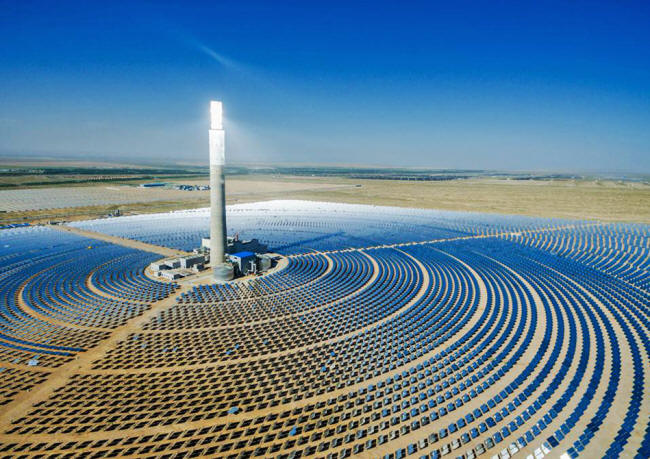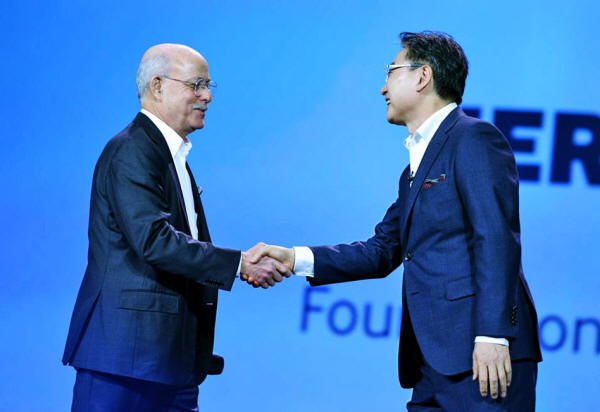|
by Daniel Araya
Getty According to author and futurist, Jeremy Rifkin (The Third Industrial Revolution - The Zero Marginal Cost Society), we are in the final phases of the fossil fuel era...
In his new book, The Green New Deal, Jeremy Rifkin argues that we are entering a zero carbon economy...
Founder and chairman of the Foundation on Economic Trends (FOET), Jeremy Rifkin (L), and the President and CEO of Samsung Electronics, Boo-Keun Yoon. picture alliance via Getty Images
This next phase of infrastructure modernization is rooted in the convergence of,
Citing a 2015 Citigroup report, Rifkin outlines the huge financial risks now facing the oil, coal and natural gas industries.
The fossil fuel industry represents stranded assets of more than $100 trillion in pipelines, ports, power plants, and ocean drilling platforms, all soon to be made obsolete.
Rifkin would know something about this.
Against the backdrop of 'rising' temperatures, collapsing ecosystems, and the threat of species extinction, Rifkin argues that key sectors of the global economy have already begun decoupling from fossil fuels.
His new book, The Green New Deal, is essentially an attempt to rouse the United States from its' slumber within a collapsing 20th century fossil fuel era.
Akin to the New Deal of the 1930s, the Green New Deal is envisioned as a long term proposal for remaking America's energy infrastructure:
The Green New Deal explained
Building on current discussions in the US Congress, this includes upgrading America's energy grid, transforming its' buildings, and transportation infrastructure, and creating a massive green collar workforce.
All the while developing green technologies and optimizing the country's overall energy efficiency.
In Rifkin's view, the key to financing this transition is the pension fund industry. Now the largest pool of capital in the world, global pension funds represent $40 trillion in investments, including $25.4 trillion in the United States alone.
But is there time?
According to the Intergovernmental Panel on Climate Change (IPCC), we have little more than 12 years to cut the emission of 'global warming' gases by 45%.
The truth is that without a fairly radical change in direction, our imploding fossil-fuel civilization will bring the Earth's ecosystems down around us.
Workers in solar cell factory, Jiangyin Jiangsu, China. Getty
The good news is that one major economy has begun driving clean energy technologies.
Where the British led the First Industrial Revolution, and the United States led the Second Industrial Revolution, it would seem that China is now poised to lead the Third Industrial Revolution.
As a report commissioned by the International Renewable Energy Agency (IRENA) observes,
China has one-third of the world's wind power, four of the top ten wind-turbine makers, six of the top ten solar-panel manufacturers, and a quarter of the world's solar capacity.
The principal market for renewable energy worldwide, China hopes to provide "green, low-carbon and circular development" to Asia's 4.3 billion consumers in the development of a "Green Belt and Road" - BRI.
At the same time, China currently remains the world's largest carbon polluter.
China burns half the world's coal and has added 40% of the world's coal capacity since 2002. In addition, its BRI ventures are responsible for the export of a wide range of "dirty energy" projects.
This is a major problem because BRI is set to underwrite much of the infrastructure for the developing world. Notwithstanding China's capacity for carbon pollution, however, Beijing is clearly pivoting to clean energy.
Forecasts suggest that China will invest more than $6 trillion in low carbon power generation and other clean energy technologies over the next 20 years.
If the United States hopes to remain significant in the 21st century it will need to dramatically step up its game.
BRI is expected to span 76 countries across four continents, overlapping one-third of global GDP, a quarter of all traded goods, and more than 60% of the world's total population.
At home, the US has now begun generating more energy from renewables than from coal.
Notwithstanding the fact that renewables represent a relatively small proportion of global power generation, the accelerating growth of clean tech innovation is set to redraw the geopolitical map of the 21st century.
|





